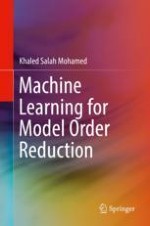2018 | OriginalPaper | Buchkapitel
2. Bio-Inspired Machine Learning Algorithm: Genetic Algorithm
verfasst von : Khaled Salah Mohamed
Erschienen in: Machine Learning for Model Order Reduction
Aktivieren Sie unsere intelligente Suche, um passende Fachinhalte oder Patente zu finden.
Wählen Sie Textabschnitte aus um mit Künstlicher Intelligenz passenden Patente zu finden. powered by
Markieren Sie Textabschnitte, um KI-gestützt weitere passende Inhalte zu finden. powered by
Abstract
-
Elitism selection: It is simply selecting the fitted individuals crated from the current population and passing them to the next population. This method guarantees a high probability of getting closer to the most optimum solution due to passing of the fittest chromosomes to the crossover operator producing fitter individuals.
-
Roulette Wheel Selection: In this kind of selection the parenthood probability is directly proportional to the fitness of the individuals. Every individual is given a weight proportional to its fitness having a higher probability to be chosen in the next generation. There is a notable disadvantage in this method of selection which is if some individuals have a higher fitness than others, there is a probability that they will be chosen as parents for every individual in the next generation. The wheel rotating can be realized by generating a random number and comparing it to random selected individual in the current generation.
-
Tournament selection: It occurs by choosing 4 or 8 or 2 n individuals from the current population and comparing each two of them randomly and so on till having one individual which is the fittest one. This process occurs as many needed time to form the new population.
-
Rank selection: In this kind of selection all individuals in the population are ranked according to their fitness. Each individual is assigned a weight inversely proportional to the rank.
-
Simple crossover: It is a process of exchanging some genes of the chromosomes or some chromosomes of the individual depending on the representation creating new individuals of new chromosomes. It depends on crossover rate which is previously identified.
-
Heuristic crossover: Choosing two individuals from the current individual randomly and computing the fitness of each individual and comparing them to each other. The fitter individual is passed to the next population and the other one is not passed and instead a new individual is created.
-
Arithmetic crossover: Arithmetic crossover occurs by choosing two or more individuals randomly from the current generation and multiplying them by one random in the case of the inevitability of the presence of a certain defined domain and more than one random if there is no physical need for a defined search domain.
